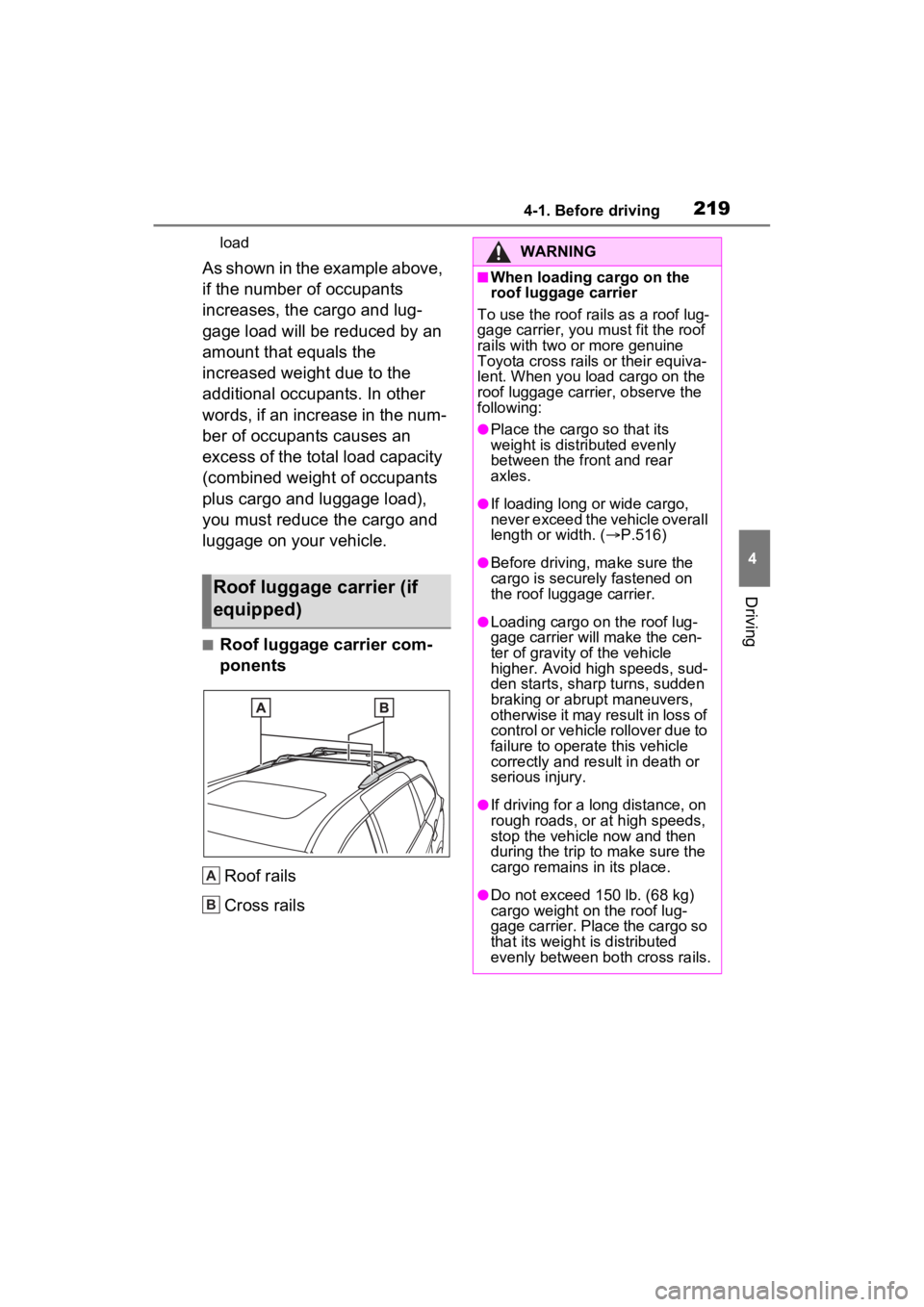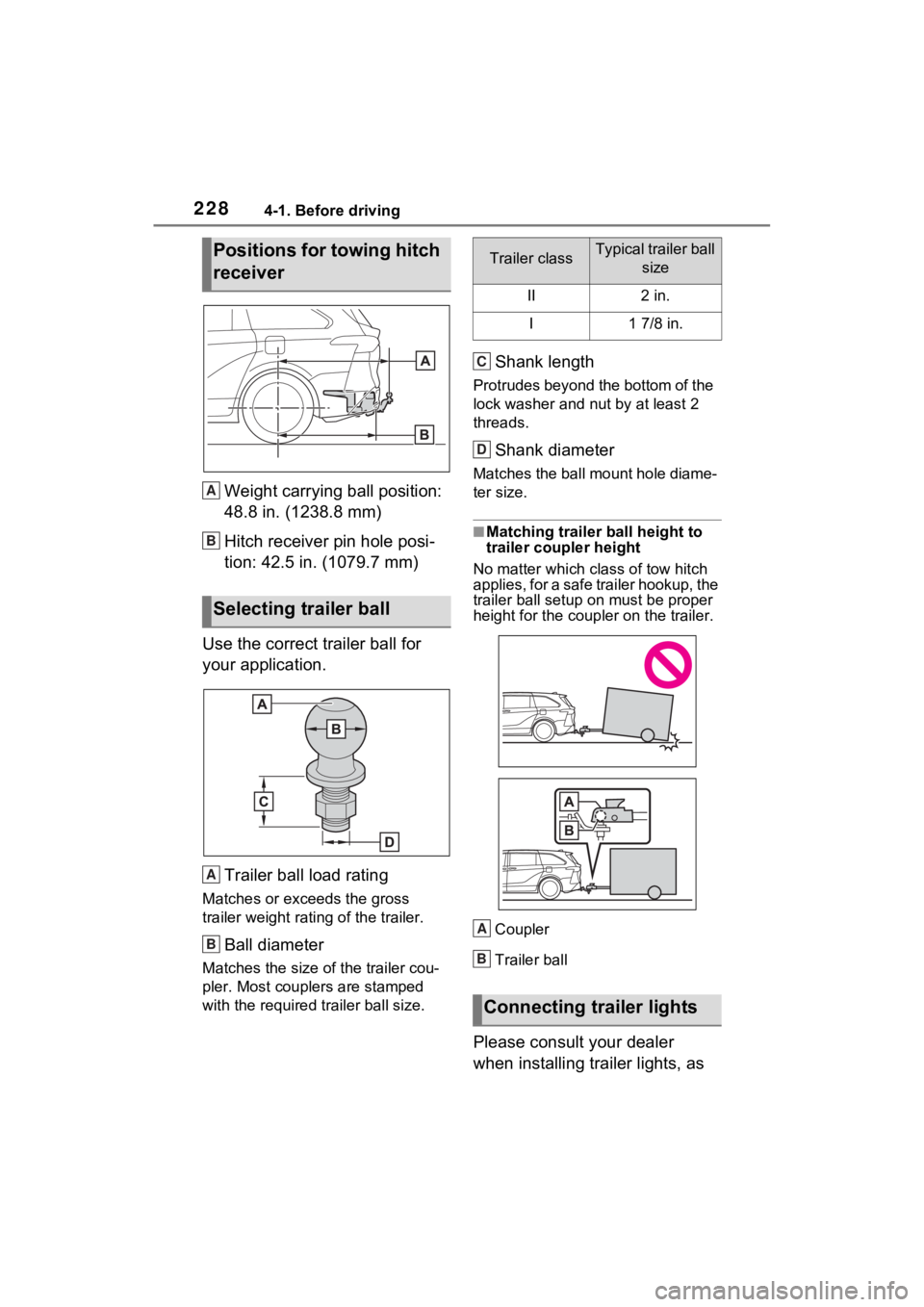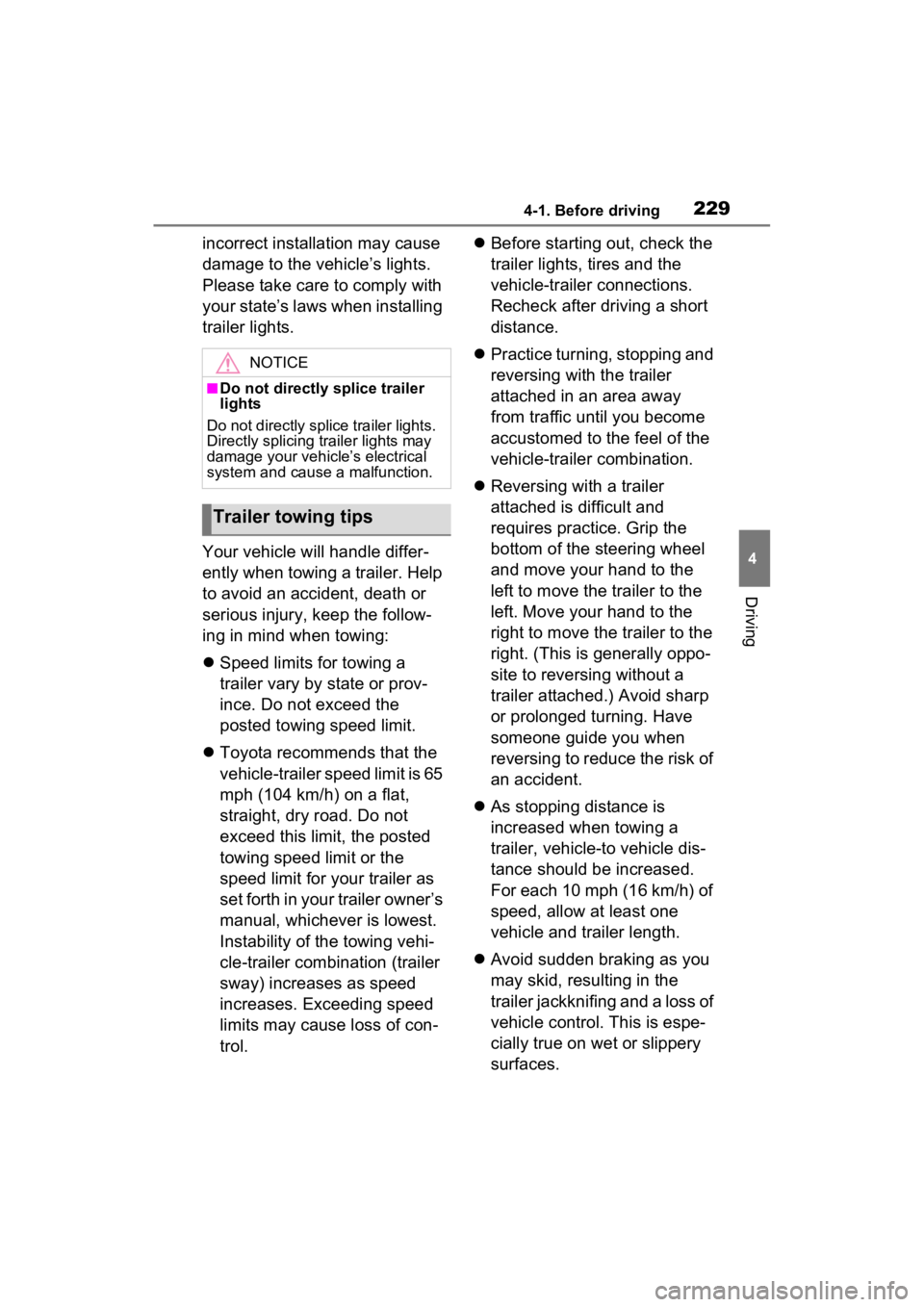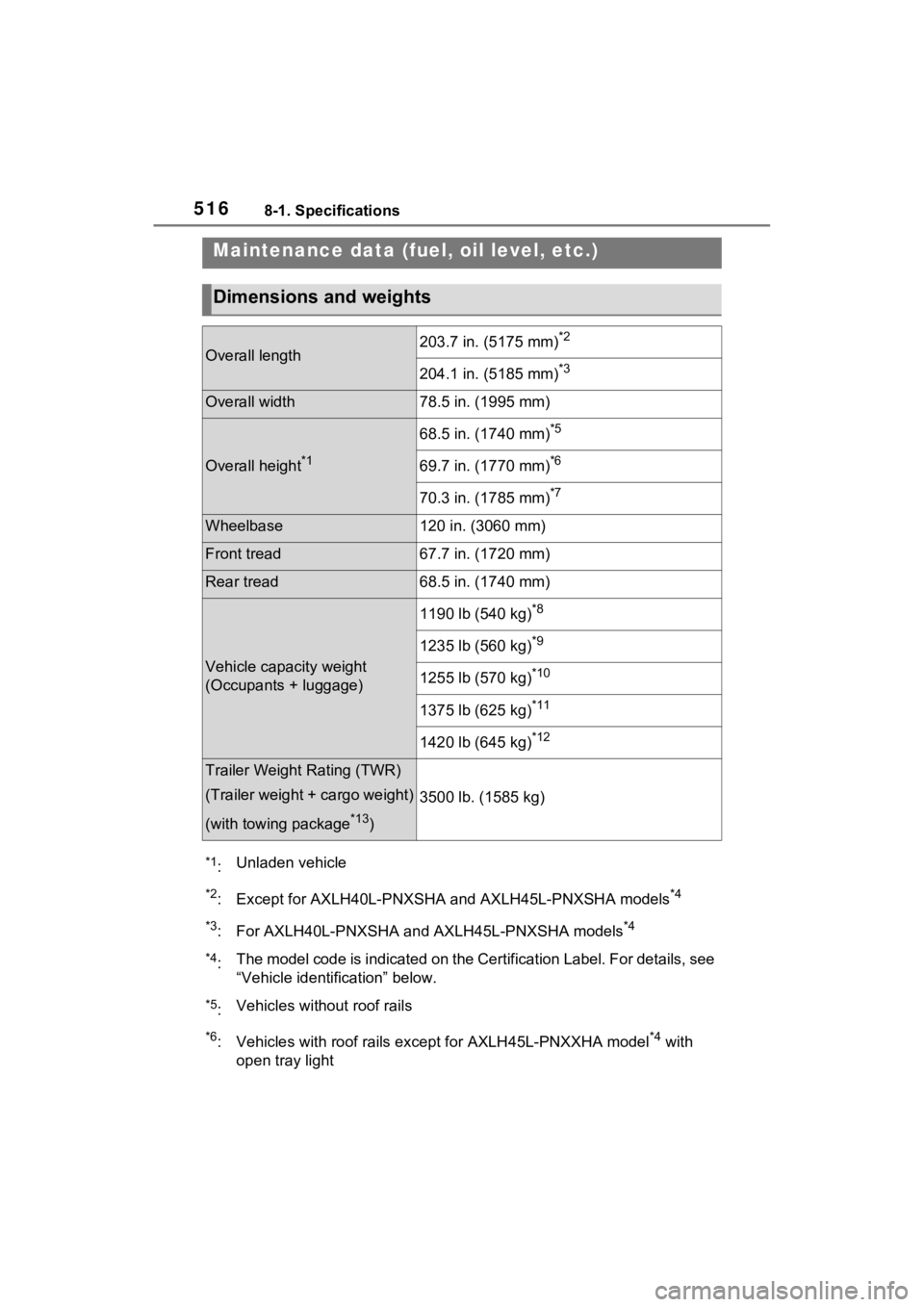2022 TOYOTA SIENNA HYBRID length
[x] Cancel search: lengthPage 220 of 600

2194-1. Before driving
4
Driving
load
As shown in the example above,
if the number of occupants
increases, the cargo and lug-
gage load will be reduced by an
amount that equals the
increased weight due to the
additional occupants. In other
words, if an increase in the num-
ber of occupants causes an
excess of the total load capacity
(combined weight of occupants
plus cargo and luggage load),
you must reduce the cargo and
luggage on your vehicle.
■Roof luggage carrier com-
ponentsRoof rails
Cross rails
Roof luggage carrier (if
equipped)
A
B
�:�$�5�1�,�1�*
■When loading cargo on the
roof luggage carrier
To use the roof ra ils as a roof lug-
gage carrier, you m ust fit the roof
rails with two or more genuine
Toyota cross rails or their equiva-
lent. When you load cargo on the
roof luggage carrier, observe the
following:
●Place the cargo so that its
weight is distributed evenly
between the front and rear
axles.
●If loading long or wide cargo,
never exceed the vehicle overall
length or width. ( P.516)
●Before driving, m ake sure the
cargo is securely fastened on
the roof luggage carrier.
●Loading cargo on the roof lug-
gage carrier will make the cen-
ter of gravity of the vehicle
higher. Avoid high speeds, sud-
den starts, sharp turns, sudden
braking or abrupt maneuvers,
otherwise it may result in loss of
control or vehicle rollover due to
failure to operate this vehicle
correctly and result in death or
serious injury.
●If driving for a long distance, on
rough roads, or at high speeds,
stop the vehicle now and then
during the trip to make sure the
cargo remains in its place.
●Do not exceed 150 lb. (68 kg)
cargo weight on the roof lug-
gage carrier. Place the cargo so
that its weight is distributed
evenly between both cross rails.
Page 229 of 600

2284-1. Before driving
Weight carrying ball position:
48.8 in. (1238.8 mm)
Hitch receiver pin hole posi-
tion: 42.5 in. (1079.7 mm)
Use the correct trailer ball for
your application.
Trailer ball load rating
Matches or exceeds the gross
trailer weight rat ing of the trailer.
Ball diameter
Matches the size of the trailer cou-
pler. Most couplers are stamped
with the required tr ailer ball size.
Shank length
Protrudes beyond the bottom of the
lock washer and nut by at least 2
threads.
Shank diameter
Matches the ball mount hole diame-
ter size.
■Matching trailer ball height to
trailer coupler height
No matter wh ich class of tow hitch
applies, for a safe trailer hookup, the
trailer ball setup on must be proper
height for the coup ler on the trailer.
Coupler
Trailer ball
Please consult your dealer
when installing trailer lights, as
Positions for towing hitch
receiver
Selecting trailer ball
A
B
A
B
Trailer classTypical trailer ball size
II2 in.
I1 7/8 in.
Connecting trailer lights
C
D
A
B
Page 230 of 600

2294-1. Before driving
4
Driving
incorrect installation may cause
damage to the vehicle’s lights.
Please take care to comply with
your state’s laws when installing
trailer lights.
Your vehicle will handle differ-
ently when towing a trailer. Help
to avoid an accident, death or
serious injury, keep the follow-
ing in mind when towing:
Speed limits for towing a
trailer vary by state or prov-
ince. Do not exceed the
posted towing speed limit.
Toyota recommends that the
vehicle-trailer speed limit is 65
mph (104 km/h) on a flat,
straight, dry road. Do not
exceed this limit, the posted
towing speed limit or the
speed limit for your trailer as
set forth in your trailer owner’s
manual, whichever is lowest.
Instability of the towing vehi-
cle-trailer combination (trailer
sway) increases as speed
increases. Exceeding speed
limits may cause loss of con-
trol.
Before starting out, check the
trailer lights, tires and the
vehicle-trailer connections.
Recheck after driving a short
distance.
Practice turning, stopping and
reversing with the trailer
attached in an area away
from traffic until you become
accustomed to the feel of the
vehicle-trailer combination.
Reversing with a trailer
attached is difficult and
requires practice. Grip the
bottom of the steering wheel
and move your hand to the
left to move the trailer to the
left. Move your hand to the
right to move the trailer to the
right. (This is generally oppo-
site to reversing without a
trailer attached.) Avoid sharp
or prolonged turning. Have
someone guide you when
reversing to reduce the risk of
an accident.
As stopping distance is
increased when towing a
trailer, vehicle-to vehicle dis-
tance should be increased.
For each 10 mph (16 km/h) of
speed, allow at least one
vehicle and trailer length.
Avoid sudden braking as you
may skid, resulting in the
trailer jackknifing and a loss of
vehicle control. This is espe-
cially true on wet or slippery
surfaces.
NOTICE
■Do not directly splice trailer
lights
Do not directly splice trailer lights.
Directly splicing trailer lights may
damage your vehicle’s electrical
system and cause a malfunction.
Trailer towing tips
Page 231 of 600

2304-1. Before driving
Avoid jerky starts or sudden
acceleration.
Avoid jerky steering and
sharp turns, and slow down
before making turn.
Note that when making a turn,
the trailer wheels will be
closer than the vehicle wheels
to the inside of the turn. Com-
pensate by making a wider
than normal turning radius.
Slow down before making a
turn, in cross winds, on wet or
slippery surfaces, etc.
Increasing vehicle speed can
destabilize the trailer.
Take care when passing other
vehicles. Passing requires
considerable distance. After
passing a vehicle, do not for-
get the length of your trailer,
and be sure you have plenty
of room before changing
lanes.
To maintain engine braking
efficiency and charging sys-
tem performance, when using
engine braking, do not use
the transmission in D.
Instability happens more fre-
quently when descending
steep or long downhill grades.
Before descending, slow
down and downshift. Do not
make sudden downshifts
while descending steep or
long downhill grades.
Avoid holding the brake pedal down too long or applying the
brakes too frequently. This
could cause the brakes to
overheat and result in
reduced braking efficiency.
Due to the added load of the
trailer, your vehicle’s hybrid
system may overheat on hot
days (at temperatures over
85°F [30°C]) when driving up
a long or steep grade. If the
engine coolant temperature
gauge indicates overheating,
immediately turn off the air
conditioning (if in use), pull
your vehicle off the road and
stop in a safe spot. ( P.509)
Always place wheel blocks
under both the vehicle’s and
the trailer’s wheels when
parking. Apply the parking
brake firmly, and put the
transmission in P. Avoid park-
ing on a slope, but if unavoid-
able, do so only after
performing the following:
1 Apply the brakes and keep
them applied.
2 Have someone place wheel
blocks under both the vehi-
cle’s and trailer’s wheels.
3 When the wheel blocks are in
place, release the brakes
slowly until the blocks absorb
the load.
4 Apply the parking brake
firmly.
Page 516 of 600

5168-1. Specifications
8-1.Specifications
Maintenance data (fuel, oil level, etc.)
Dimensions and weights
Overall length203.7 in. (5175 mm)*2
204.1 in. (5185 mm)*3
Overall width78.5 in. (1995 mm)
Overall height*1
68.5 in. (1740 mm)*5
69.7 in. (1770 mm)*6
70.3 in. (1785 mm)*7
Wheelbase120 in. (3060 mm)
Front tread67.7 in. (1720 mm)
Rear tread68.5 in. (1740 mm)
Vehicle capacity weight
(Occupants + luggage)
1190 lb (540 kg)*8
1235 lb (560 kg)*9
1255 lb (570 kg)*10
1375 lb (625 kg)*11
1420 lb (645 kg)*12
Trailer Weight Rating (TWR)
(Trailer weight + cargo weight)
(with towing package
*13)
3500 lb. (1585 kg)
*1:Unladen vehicle
*2:Except for AXLH40L-PNXSHA and AXLH45L-PNXSHA models*4
*3:For AXLH40L-PNXSHA and AXLH45L-PNXSHA models*4
*4:The model code is indicated on the Certification Label. For det ails, see
“Vehicle identification” below.
*5:Vehicles without roof rails
*6:Vehicles with roof rails e xcept for AXLH45L-PNXXHA model*4 with
open tray light